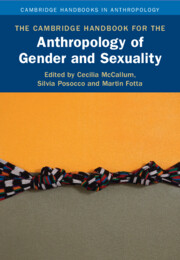Book contents
- The Cambridge Handbook for the Anthropology of Gender and Sexuality
- Cambridge Handbooks in Anthropology
- The Cambridge Handbook for the Anthropology of Gender and Sexuality
- Copyright page
- Contents
- Contributors
- 1 Introduction to The Cambridge Handbook for the Anthropology of Gender and Sexuality
- Part One Openings and Orientations
- Part Two Knowledges and Domains
- Part Three Resistances and Intersections
- 12 Social and Cultural Politics of Everyday Resistance and Empowerment
- 13 Reworking Black Feminist Anthropology through Transnational Scholar-Activism and Antiracist Solidarity in Africa and Its Diaspora
- 14 Gender in Decolonial Indigenous Perspectives
- 15 Anthropologies of Reproduction, Abortion, and Biopolitics
- 16 Gender, Capitalism, and the Erotics of Finance
- 17 Untying Poverty’s Gendered Knots Past and Present
- Part Four Desires and Relations
- Part Five Recursivities and Futures
- Name Index
- Subject Index
- References
15 - Anthropologies of Reproduction, Abortion, and Biopolitics
from Part Three - Resistances and Intersections
Published online by Cambridge University Press: 29 September 2023
- The Cambridge Handbook for the Anthropology of Gender and Sexuality
- Cambridge Handbooks in Anthropology
- The Cambridge Handbook for the Anthropology of Gender and Sexuality
- Copyright page
- Contents
- Contributors
- 1 Introduction to The Cambridge Handbook for the Anthropology of Gender and Sexuality
- Part One Openings and Orientations
- Part Two Knowledges and Domains
- Part Three Resistances and Intersections
- 12 Social and Cultural Politics of Everyday Resistance and Empowerment
- 13 Reworking Black Feminist Anthropology through Transnational Scholar-Activism and Antiracist Solidarity in Africa and Its Diaspora
- 14 Gender in Decolonial Indigenous Perspectives
- 15 Anthropologies of Reproduction, Abortion, and Biopolitics
- 16 Gender, Capitalism, and the Erotics of Finance
- 17 Untying Poverty’s Gendered Knots Past and Present
- Part Four Desires and Relations
- Part Five Recursivities and Futures
- Name Index
- Subject Index
- References
Summary
Exploring key trajectories of feminist anthropologies of reproduction, this chapter demonstrates how issues surrounding procreation and its prevention have provided the terrain for major insights about cultural and political dynamics since the very beginning of anthropology itself. The notion of stratified reproduction proved pivotal for broadening the ethnographic gaze on reproductive practices to include global processes, inspiring feminist anthropologists to highlight the multiple forms of inequality and the multiplication of inequalities within and across borders. The author focuses on theoretical debates that have both influenced the feminist anthropologies of reproduction and, in turn, been impacted by it – questions of Foucauldian biopolitics. The author begins by outlining Foucault’s notion of biopower, and then explores some of the diverse ways that feminist anthropologists have related to concepts of biopolitics in theorizing the study of reproduction. The third section illuminates anthropologies of abortion that have variously pursued feminist politics, and/or the analytical concerns of biopolitics, at times bringing them together and at others considering them to be discrete agendas. Finally, the chapter explores feminist anthropologies of abortion in state socialist and postsocialist societies, arguing that these political-economic and social contexts offer important directions for understanding reproduction, the state, and biopolitics.
- Type
- Chapter
- Information
- Publisher: Cambridge University PressPrint publication year: 2023



